Introduction
Overview
How to search the Ordnance Survey Name Books
Missing Ordnance Survey Name Books
Related records
Related records not held by NRS
Further reading
Introduction
The Ordnance Survey Name Books (or 'original object name books') list every place name found on the 1st edition Ordnance Survey maps of Scotland. The name books, along with modern transcriptions, can be searched and accessed on Scotland’s People.
They provide information about almost all man-made and natural features of the landscape that inform the 1st edition of the Ordnance Survey mapping of Scotland, which took place from the 1840s to 1878.
These records will be of particular interest to local and family historians, hoping to gain insight into the evolution of the Scottish landscape and of the places their ancestors worked and lived. They also provide insight into the sources of names, their meanings, different spellings of place names, archaeological finds and the individuals involved in collecting this information.
Overview
The name books are arranged by county, and the number of volumes for each county varies. The collectors who gathered the geographical information listed place names by parish, and the parish name can often be found at the top of each page.
The following is a list of the OS Name Books arranged by county alphabetically and the dates they were surveyed. The NRS catalogue reference is also given:
• Aberdeenshire OS Name Books, 1865-1871 (NRS, OS1/1/1-91)
• Argyll OS Name Books, 1868-1878 (NRS, OS1/2/1-81)
• Ayrshire OS Name Books, 1855-1857 (NRS, OS1/3/1-63)
• Banffshire OS Name Books, 1867-1869 (NRS, OS1/4/1-28)
• Berwickshire OS Name Books, 1856-1858 (NRS, OS1/5/1-41)
• Buteshire OS Name Books, 1855-1864 (NRS, OS1/6/1-7)
• Caithness OS Name Books, 1871-1873 (NRS, OS1/7/1-15)
• Clackmannanshire OS Name Books, 1861-1862 (NRS, OS1/8/1-7)
• Dumfriesshire OS Name Books, 1848-1858 (NRS, OS1/10/1-55)
• Dunbartonshire OS Name Books, 1860 (NRS, OS1/9/1-18)
• East Lothian OS Name Books, 1853-1854 (NRS, OS1/15/1-55)
• Fife and Kinross-shire OS Name Books, 1853-1855 (NRS, OS1/13/1-135)
• Forfarshire (Angus) OS Name Books, 1857-1861 (NRS, OS1/14/1-84)
• Inverness-shire OS Name Books, 1876-1878 (NRS, OS1/16/1-16 Skye; NRS, OS1/17/1-57 Mainland; NRS, OS1/18/1-13 Outer Hebrides)
• Kincardineshire OS Name Books, 1863 (NRS, OS1/19/1-20)
• Kirkcudbrightshire OS Name Books, 1848-1851 (NRS, OS1/20/1-159)
• Lanarkshire OS Name Books, 1858-1861 (NRS, OS1/21/1-59)
• Midlothian OS Name Books, 1852-1853 (NRS, OS1/11/1-135)
• Morayshire OS Name Books, 1868-1871 (NRS, OS1/12/1-23)
• Nairnshire OS Name Books, 1869 (NRS, OS1/22/1-7)
• Orkney OS Name Books, 1879-1880 (NRS, OS1/23/1-26)
• Peeblesshire OS Name Books, 1856-1858 (NRS, OS1/24/1-47)
• Perthshire OS Name Books, 1859-1862 (NRS, OS1/25/1-79)
• Renfrewshire OS Name Books, 1856-1857 (NRS, OS1/26/1-21)
• Ross and Cromarty OS Name Books, 1848-1876 (NRS, OS1/27/1-136 insular; NRS, OS1/28/1-58 Mainland)
• Roxburghshire OS Name Books, 1858-1860 (NRS, OS1/29/1-42)
• Selkirkshire OS Name Books, 1858 (NRS, OS1/30/1-15)
• Shetland OS Name Books, 1877-1878 (NRS, OS1/34/1-26)
• Stirlingshire OS Name Books, 1858-61 (NRS, OS1/32/1-27)
• Sutherland OS Name Books, 1871-1875 (NRS, OS1/33/1-35)
• West Lothian OS Name Books, 1855-1859 (NRS, OS1/34/1-69)
• Wigtownshire OS Name Books, 1845-1849 (NRS, OS1/35/1-88)
The ‘original object name books’ used in Scotland came in two forms, each with a different system of headed columns.
The first type, commonly used in surveying and naming the Highland parishes, was essentially a 'field' version of the name book and had five headings: Received name; Object; Description; Township or parish; and Authority for spelling, with their names and addresses. The collector (sometimes referred to as an ‘examiner’), usually an officer in the Ordnance Survey, would consult local historians and etymologists (called authorities in the books) in order to fix the spelling (the received name) of each 'object' (natural feature, inhabited place, building and so on).
A second type, used commonly in the Lowlands, had an additional column: 'Orthography as recommended to be used in the new Plans'. Another column of 'Descriptive Remarks, or other General Observations which may be considered of Interest' usually duplicated the information contained in the 'Description' column, but additional information was sometimes given. This fuller version was completed by staff in the local Ordnance Survey office who might have added further information from sources such as early maps, historical texts or local scholarly bodies.
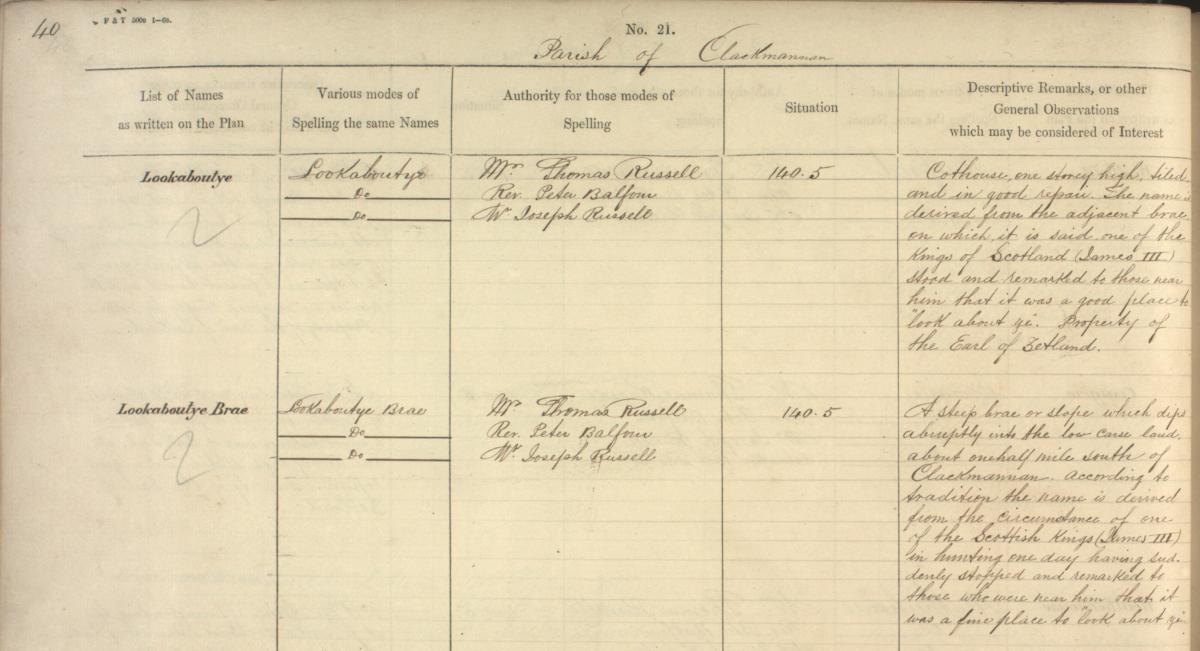
Crown copyright, National Records of Scotland (NRS), OS1/8/3 page 40
This example of the first type of the name books is from the county of Clackmannan (NRS, OS1/8/3) which describes the place Lookaboutye Brae. The column headed ‘Descriptive Remarks, or other General Observations which may be considered of Interest’ helpfully informs us of its appearance and the origin of this unusual place name:
“A steep brae or slope which dips abruptly into the low carse land, about one half mile south of Clackmannan according to tradition the name is derived from the circumstance of one of the Scottish Kings (James III) in hunting one day having suddenly stopped and remarked to those who were near him that it was a fine place to "look about ye"."
The spelling of this place name has been confirmed by three individuals, including a Reverend Peter Balfour, seen in columns two and three. If a search is made for the same place name today using an online search engine, the origins of the place name concerns a hunting trip in the area by Robert the Bruce, who, on losing a glove, instructs his men to ‘look about ye’ for it. It is an interesting variation on the story cited in the Victorian OS Name Book.
The collectors relied on knowledgeable locals to supply them with accurate names. Their instructions were to consult landowners and their agents first, then other people of standing, such as parish ministers, postmasters and school teachers. In practice, and especially in remoter areas, they turned to humbler people such as tenants, shepherds and labourers. In Gaelic-speaking areas, they sometimes worked through interpreters.
This example of the second type of name book, with six headings, records the ‘Register Office’, now known as General Register House in Edinburgh:
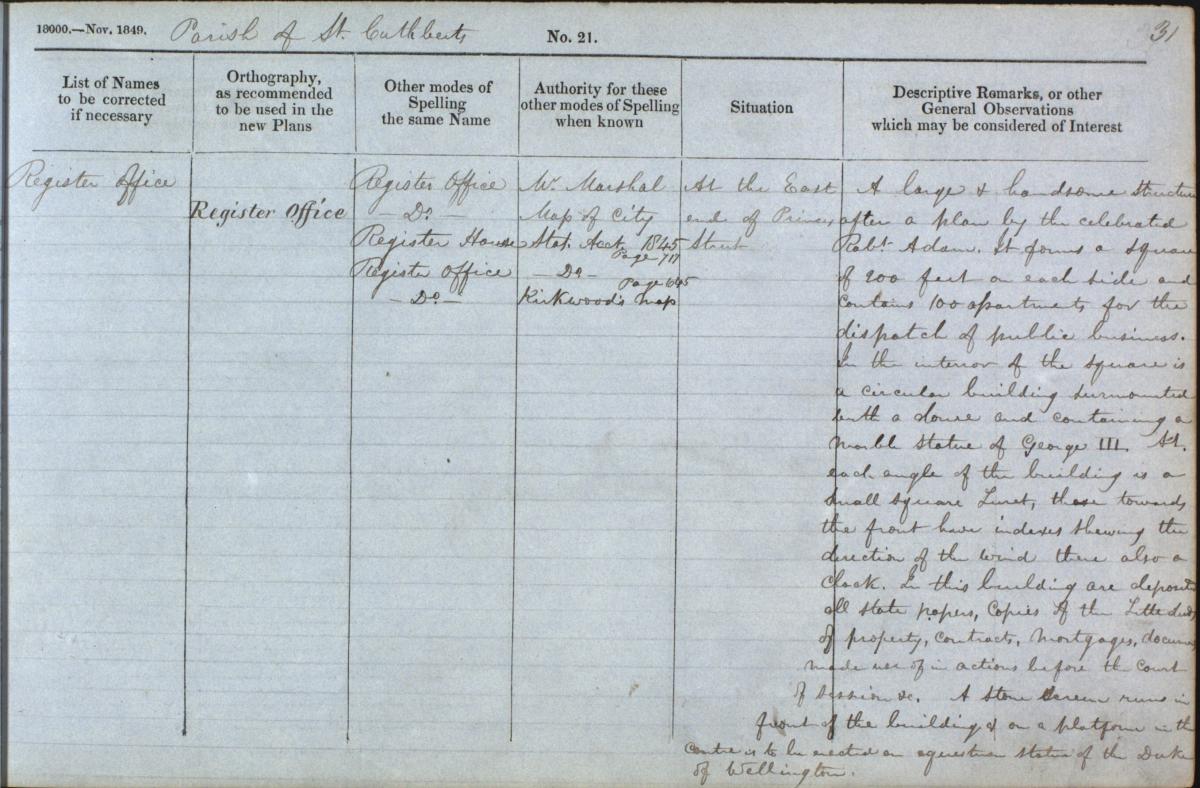
Crown copyright, NRS, OS1/11/99 page 31
"A large and handsome structure after a plan by the celebrated Robert Adam. It forms a square of 200 feet on each side and contains 100 apartments for the dispatch of public business. In the interior of the square is a circular building surmounted with a dome and containing a marble statue of George III. At each angle of the building is a small square turret, these towards the front have indexes showing the direction of the wind there also a clock. In this building are deposited all state papers, copies of title deeds of property, contracts, mortgages, documents made use of in actions before the court of session etc. A stone [.] runs in front of the building and on a platform in the centre is to be erected an equestrian statue of the Duke of Wellington.”
This description of General Register House is still accurate today, although the types of records held within it have increased. The name book also notes that the building has been recorded as ‘Register House’ and ‘Register Office’ and the authority for these names is from existent maps. Gazetteers and maps were also consulted to accurately inform the OS Name Books.
Not all name books are so neatly set out. You may come across annotations correcting spellings of names and occasionally drawings of features of the land, such as ruined buildings, standing stones and archaeological finds. This page, below, is one example. The collector has taken the time to sketch standing stones found in the parish of Inverurie at Brandsbutt, Drummies and in the church yard at Inverurie. The page in the name book the sketch refers to is also noted. You will notice that there is some indecision over the spelling of ‘Inverury’, which is corrected throughout the name book.
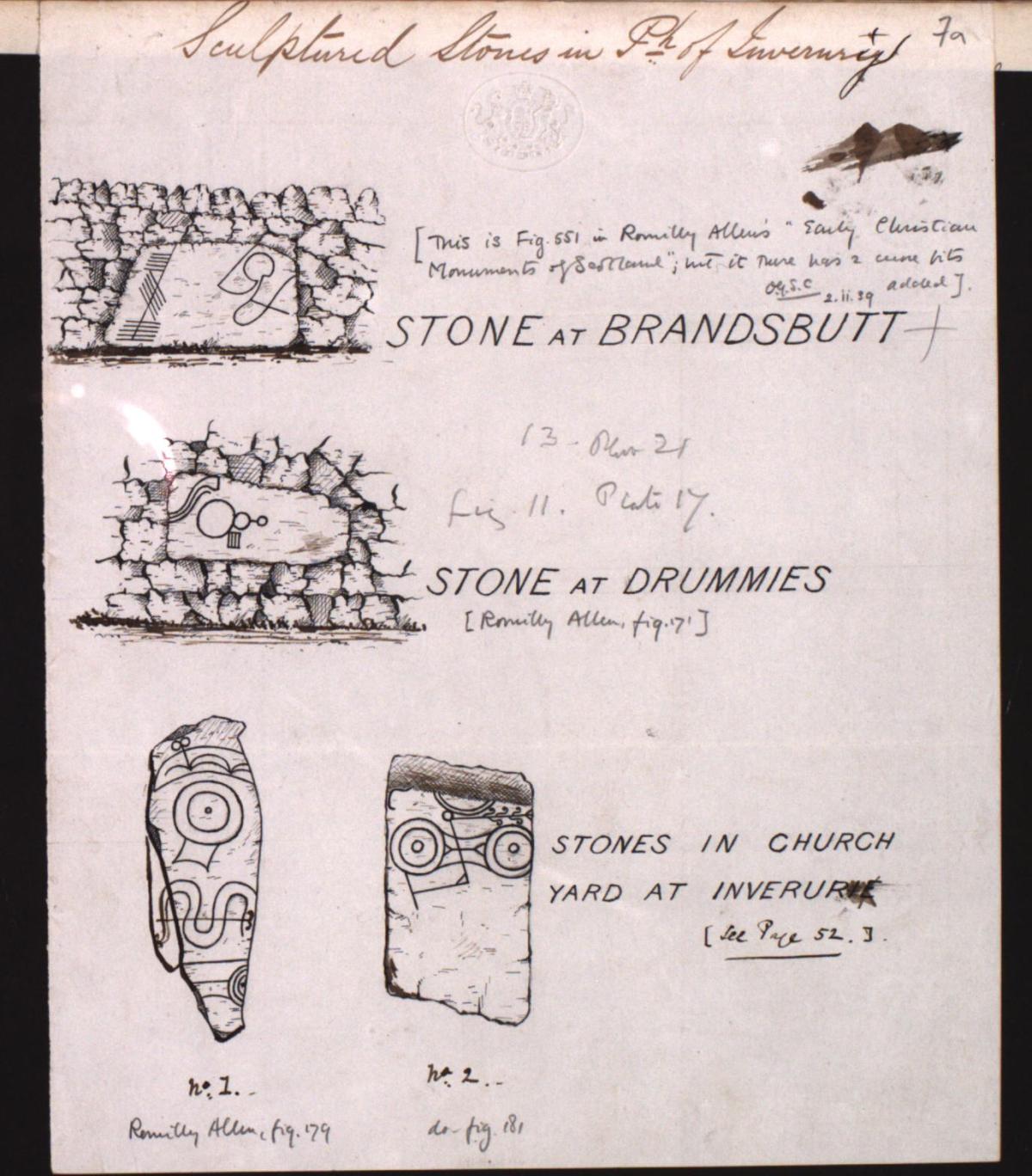
Crown copyright, NRS, OS1/1/42 page 7A
To discover more surprises found in the OS Name Books, read our feature article.
How to search the Ordnance Survey Name Books
The name books are not indexed. You can use the dedicated Virtual Volumes OS Name Books search area to search and view nearly 2000 volumes of name books, covering all of Scotland and the islands.
Our guide on Using Virtual Volumes provides additional information on searching un-indexed records on Scotland’s People. You can also make searches for these records within the Virtual Volumes ‘Volume search’ area if you prefer, which enables you to search for any types of digital records held within Virtual Volumes.
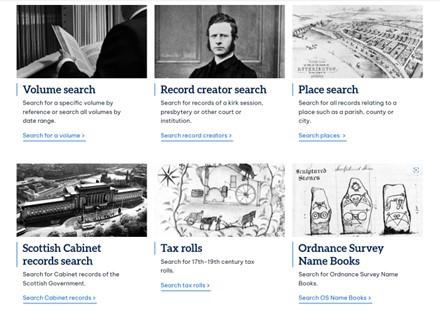
Crown copyright, NRS
Within the OS Name Books search area there are two distinct search forms, shown below. Both search forms include search tips for each field.
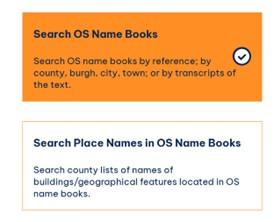
Crown copyright, NRS
Search form 1 – Search OS Name Books
The ‘Search OS Name Books’ form allows you to search the volumes using some or all of the following search fields:
- Record type (a list of counties)
- Year range (Year from/Year to)
- Place search (to search by county, burgh, city or town)
- Transcription search (to search plain text transcriptions of the manuscript or printed text in the volumes, if available)
- Reference (if you know the volume reference you require – a link to the National Records of Scotland public catalogue is provided)
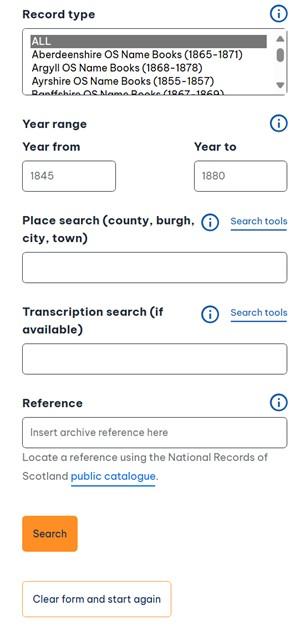
Crown copyright, NRS
The OS Name Books have descriptions which include parish, burgh, town and city names. By entering a search term into the ‘Place search’ field you can search these descriptions for a particular place. If the ‘Place search’ field is used your search will produce a list of volumes that meet the search criteria.
The text in most of the OS Name Books has been fully transcribed through a crowd-sourcing project. The transcription is a plain text copy of the manuscript or printed text on the original record. These transcriptions were captured over a number of years as a volunteer project. It is acknowledged that these are not 100% accurate, but they are provided as a useful finding aid for researchers.
You can use the ‘Transcription search’ field to search the transcriptions for specific keywords, such as a place or individual name. If any search term is entered into the ‘Transcription search’ field, the results will return a set of results arranged by record type, in the format shown below.

Crown copyright, NRS
Any search without a term in the ‘Transcription search’ field will return a list of volumes. Any search which does include a term in the ‘Transcription search’ field will return results in the list format shown above.
Please note that if you include a term in the ‘Place search’ field, you cannot search using the ‘Transcription search’ and vice versa. For both these fields you can use the search tools option to tailor your results to include any word in your search, all words or an exact phrase.
Search form 2 - ‘Search Place Names in OS Name Books’
The ‘Search Place Names in OS Name Books’ function allows you to search the volumes for particular locations, listed in the name book indexes. These locations, referred to as ‘objects’, can include places such as buildings or landscape features, either natural or man-made.
The search form includes a list of counties. One county at a time can be selected from the drop-down list.
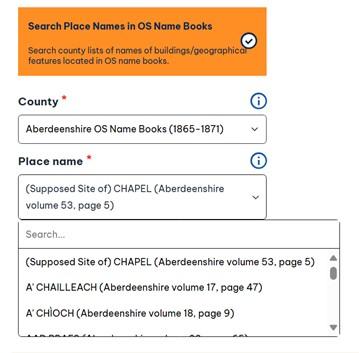
Crown copyright, NRS
Place names can be selected from the second drop-down list. As you type into the ‘Place name’ search field, the list of place names reduces. For example, typing ‘Abb’ will reduce the list to begin with those place names which begin ‘Abb’
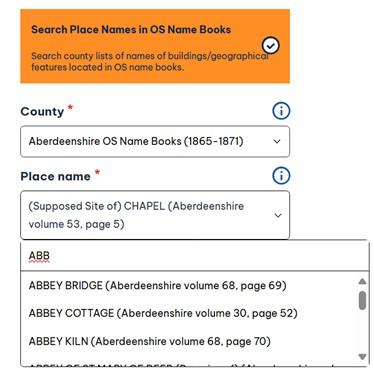
Crown copyright, NRS
In this example, the place name ‘ABBEY BRIDGE’ is selected. The user can click on ‘View’ and this will open the relevant volume at the page which includes Abbey Bridge.
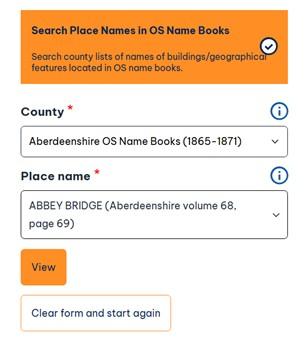
Crown copyright, NRS
The place names given in the ‘Place name’ drop-down are derived from handwritten indexes in the volumes. You can view images of the original index pages. These can be found using the ‘Volume contents’ function within the image viewer. For more information on using ‘Volume contents’, please see our Virtual Volumes user guidance.
Missing Ordnance Survey Name Books
There are a number of OS Name Books missing from NRS’ collection.
During the Second World War, while the OS Name Books were stored at Southampton, they were damaged during an air raid. In these attacks the main stores took a direct hit and the subsequent fire destroyed, among many other valuable documents, nearly all the name books for England and Wales. The Perthshire Survey of 1859-1864 was particularly affected. Among the volumes destroyed were those covering the whole extent of the county surveyed at the scale of six inches to one mile, certain detached parts of parishes, and the following parishes surveyed at 25 inches to one mile:
- Arngask
- Balquhidder
- Blair Atholl
- Comrie
- Fortingall proper
- Kenmore proper
- Killin
- Kirkmichael
- Moulin
- Weem proper
It is probable that many of the six-inch scale name books for Perthshire, including those for Menteith, suffered the same fate, although the 25-inch name books for Menteith did survive.
Related records
The OS Name Books were revised between 1892 to 1952 and are referred to as Ordnance Survey Name Books second (revision) series (NRS, OS2).
For those records not available on Scotland’s People, further information can be found by consulting the NRS Online Public Catalogue. They can be viewed, by prior appointment, in the NRS Historical Search Room at General Register House, Edinburgh.
Related records not held by NRS
The related 1st edition of the six-inch to the mile OS maps, created from the name books, can be accessed on the National Library of Scotland website. A link to the website is provided on the OS Name Books search form in Virtual Volumes.
The equivalent OS Name Books for England and Wales were destroyed during a bombing raid on OS Headquarters at Southampton in 1940.
Further reading
Ordnance Survey Maps - Six-inch 1st edition, Scotland, 1843-1882: A Scottish paper landscape by Christopher Fleet and Charles W J Withers
The collection of antiquarian information for the early Ordnance Survey maps of Scotland by J L Davidson, Society of Antiquities Scotland, Vol 116, 1986
Guides to the Scots and Gaelic origin of place names in Britain can be found on the OS website at: The Scots origins of place names in Britain and The Gaelic origins of place names in Britain.